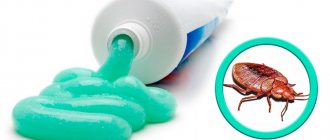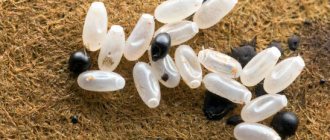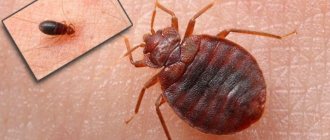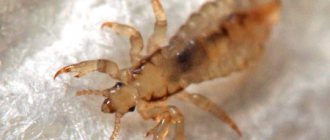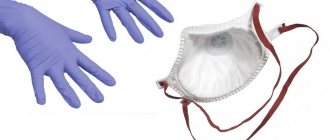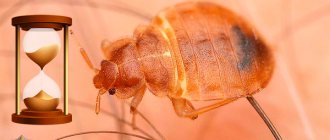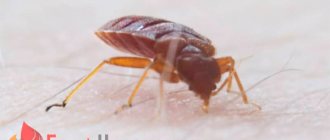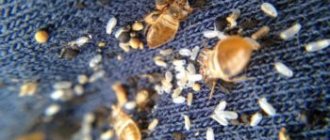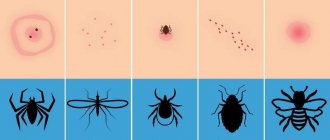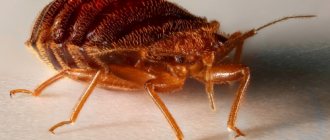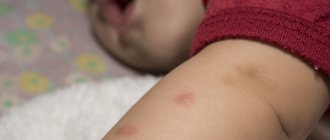- Features of the reproduction of domestic bugs
- What does nympha look like?
- Five larval instars
- Bedbug larva feeding
- How to find larvae?
- Differences from juveniles of other parasites
- Destruction of bed bug larvae
- Danger of larvae
- When are nymphs good and bad?
- Why are nymphs difficult to breed?
- Which insecticides have an ovicidal effect?
- How to properly get rid of larvae?
- What are the best remedies for bedbug larvae?
One of the most unpleasant features of linen or bed bugs is their incredible fertility. Insects form large populations in record time. The danger is posed not only by adult bedbugs, but also by bedbug larvae. They are also called nymphs, but a detailed description of the appearance of these creatures leads far away from the association with beautiful fairy-tale characters.
Features of the reproduction of domestic bugs
Synanthropic insects live off human blood. This nutrient medium promotes the rapid development of “embryos” in the female’s body. The better the adult feeds, the faster the egg, ready for laying, matures.
The female bedbug is fertilized once in her life. The seminal fluid is consumed gradually; the individual is capable of producing offspring throughout its life after one fertilization. The female lays 4-10 eggs per day; a very well-fed individual can lay 20, and over the course of her life – up to 500.
Domestic sofa bed bugs are insects with an incomplete transformation cycle. This means that there is no stage of pupal formation; larvae immediately emerge from the egg, which over time become sexually mature parasites.
How bedbugs get into apartments
Most often, when we arrive at a new apartment, we don’t even realize that they are already there.
If we leave our home, the bedbugs and larvae will not suffer from hunger - they will simply go into suspended animation, waiting for the smell of fresh blood to wake them up.
We will take some of the bloodsuckers with us, unaware of their move. Together with the “infected” things, they will move to a new home and quickly master it.
The female bug is unusually prolific - one individual lays more than 500 larval eggs in less than a year of life, and this is 5-12 larvae per day! The larvae are neatly stacked in secluded places, as if in incubators. The maturation period is only one week.
The individual emerging from the egg is not an adult bug, but has all the properties (except reproduction) of a “mature” bug. And the main “gift” is the ability to find a victim and drink blood from it.
So the population of extremely tenacious insects will not only grow at an alarming rate, but also immediately make night forays in search of food.
What does nympha look like?
The offspring of blood-sucking insects are similar to adults; they are almost exact copies of adult parasites. It is for this reason that the entomological term “nymphs” is applied to them, meaning that the body structure is very similar to adult individuals. The difference is that adult insects have stripes on their bodies that are invisible in their offspring.
External characteristics and structure of the larvae:
- flat body, somewhat rounded in satiated individuals;
- transparent yellowish color. Because of the color on unpainted wooden surfaces, creatures may not be noticed; they blend into the surface;
- three pairs of limbs on the chest;
- antennae necessary for searching for food, acting like antennas;
- scent glands on the lower abdomen.
Looking at the drawing of apartment nymphs, you can notice all the described structural elements, but these are macro photographs. On a light mattress or in a sofa box, you may not notice them with the naked eye, but you may not understand that this entity is insects.
The incubation period, under favorable conditions, lasts 5-7 days, then, after breaking through the shell of the egg, the larvae are born. Before becoming a sexually mature insect, nymphs go through five stages of development.
Sizes of bedbug nymphs
As the larva grows, its body increases in size and it becomes more noticeable and more similar to adult bedbugs. If an adult has a body length of 5-6 mm, then the body length of a nymph ranges from 1-4 mm. Moreover, if adult bugs are brown, then the nymphs are either yellow with a translucent body, or crimson-red if they have just fed. They need to be distinguished only from eggs - they are white and similar to grains of rice - and from excrement - they are round and black, similar to fixed points.
By the way, hungry nymphs may not be noticed, for example, on an unpainted tree, on the same bed frame, because they blend in with it in color. But the engorged nymphs are very clearly visible, they simply look like running droplets of blood.
If you look at the nymph at all, you can see through the covering of her body the stomach, the black contents of her intestines and other internal organs. When such a larva sucks blood, you can see how this blood flows into the stomach.
Five larval instars
Immediately after emerging from the egg, the nymph has very soft covers, the body is almost transparent, its length is up to one and a half mm. All that is noticeable on the individual is the red eyes located on the sides of the head. The bug nymph spends five to six days in this form.
Further periods of development:
- over the next 5-7 days, the length of the body increases to 2 mm, the color becomes brown, short hairs and antennae grow, and the nymph can already search for the victim. Towards the end of the period, the first molt occurs;
- in the third period of life, the bedbug larva grows to 2.5 mm. The nymph is capable of fully biting people and feeding on their blood. Unlike adults, at this stage of development the offspring are not capable of rapid movement due to poorly developed limbs;
- at the fourth stage, adequate blood nutrition ensures growth of up to 3 mm. Over the course of five days, the nymph gains energy and prepares for the next molt. The rudiments of wings form on the body;
- at the stage before the imago, the “growth” of the nymph is 4-5 mm. They actively feed, and after saturation with blood, the brown color changes to red. If you turn on the light suddenly at night, the insect is easy to spot.
After molting for the last time, the larva becomes an imago, ready for mating. Adult males are somewhat smaller than females and their bellies are flatter. Throughout life, they can still increase in size, but they no longer molt. The life cycle of nymphs gives an affirmative answer to the question of whether the larvae bite. They are able to do this starting from the second life period.
Nutrition is the main condition for the development of parasites. They cannot progress to the next stage unless they receive blood. The frequency of meals is once every few days.
Bedbug larvae also bite
The parasitic lifestyle is typical for both adults and nymphs. The mouthparts are adapted to piercing the skin and sucking blood, so the larvae also bite.
How the larvae bite:
- The parasite's jaws resemble piercing bristles in appearance.
- To get into the desired artery, the larvae perform several bites, leaving numerous marks.
- After each night their number increases.
When a sexually mature bug attacks, it injects the victim with a substance that has an anesthetic effect. Due to the underdevelopment of the glands, nymphs lack this feature, so their bites are more painful.
Bedbugs prefer areas of the body with delicate skin. More often, bites are found on the face, neck, back, and limbs. They should not be combed, otherwise there is a high probability of infection in the wounds. To relieve itching and inflammation the following are used:
- antihistamines;
- lotions;
- traditional medicine (soothing herbs);
- ointments.
If there are no complications, the bites go away on their own within 3 days.
How to find larvae?
You should look for “young” parasites in the same place as adults. If you suspect a colony, carefully examine:
- mattress seams;
- upholstery, back panels, box, folds of the sofa;
- joints of wallpaper and baseboards;
- gaps between walls and baseboards;
- spaces between walls and paintings;
- all the furniture in the bedroom;
- the back of household appliances;
- chests of drawers where bed linen is stored;
- folds in clothes.
Parasites can live on any of the items listed. You need to look for the individuals themselves, their excrement, and the remains of the chitinous cover.
How to detect the presence of insects
Parasites prefer to settle closer to the food source - humans. The larger the colony, the easier it will be to find them.
House bugs prefer old baseboards, wallpaper that has come off the walls, and cracks in floors and walls.
Bed bloodsuckers are found in the seams of linen, mattresses, and on the inside of beds. Some live right in feather pillows (not to be confused with feather mites!).
If after sleep your skin is covered with small itchy bites and wounds, then most likely you have been attacked by blood-sucking settlers.
Inspect your bed - are there tiny bloody spots on the sheets and pillowcases? Explore your home - have strange bugs settled in the cracks dangerously close to your resting place? Behind the wallpaper or under the bottom of the bed you will find a scattering of dark traces - feces and old chitinous shells - traces of the presence and molting of bedbugs. As the bedbug larva grows, it changes its “clothes” as many as 5 times!
Differences from juveniles of other parasites
Unfortunately, in an apartment there may be not only parasites of the order of bedbugs, but also other adult and young harmful insects. Remember their “signs”:
- the offspring of cockroaches are larger in size, darker in color, and the antennae are longer;
- Young ticks have no whiskers, have 4 pairs of legs, and have a round body shape;
- the offspring of ants have a clear division of the body into two sections, the bottleneck is visually indicated;
- small fleas have an elongated body; they do not run, but jump.
It is possible to defeat parasites!
Antiparasitic Complex® - Reliable and safe removal of parasites in 21 days!
- The composition includes only natural ingredients;
- Does not cause side effects;
- Absolutely safe;
- Protects the liver, heart, lungs, stomach, skin from parasites;
- Removes waste products of parasites from the body.
- Effectively destroys most types of helminths in 21 days.
There is now a preferential program for free packaging. Read expert opinion.
Read further:
Bedbug bite in a child and an adult: what it looks like and how you can get rid of it
Life cycle of bed bugs reproduction in an apartment
Roundworms: size, color, nature of movements, shape of eggs and larvae
No to ticks: where to order insect repellent treatment?
How long does a mosquito live: life expectancy, after a bite, in an apartment
How to effectively and permanently remove bed bugs from your apartment
Danger of larvae
There are always more developing individuals in the apartment than adults. The development period of the offspring is about a month, i.e. already after this period, the first descendants of the female begin to reproduce. There is no threat to insects in your home: there are no parasites that could destroy them, there is food and secluded places for nests. Every night, several dozen adult bedbugs and maturing parasites bite members of your family. They, growing up, are essentially more dangerous than adult parasites; they live in the same place and lead the same lifestyle.
Another cunning trick of nymphs is that under unfavorable external conditions they fall asleep. It only takes the temperature to drop below 15℃ for this to happen. This feature is misleading. Owners may think that they have gotten rid of bedbugs, but as soon as the temperature rises, they will wake up and begin to reproduce.
The fivefold molting of young individuals does not pass without a trace. Remains of chitinous coating on bedding, sleepwear, and bedroom furniture can cause allergic reactions, rhinitis, and asthma. The shed skins outnumber the adult dead bedbugs (if they have started to poison them). If they are found, they must be carefully removed with a vacuum cleaner and the room must be treated with suitable preparations.
Nymphs as a cause of allergies
In addition, during its development, it changes its chitinous covers 5 times. The dry skins remaining from them are destroyed over time and mixed with dust, and when air moves, they can rise and enter the human respiratory tract.
These skins contain very aggressive allergens, which often cause chronic rhinitis with runny nose and nasal congestion, dermatitis. And over time, such chronic rhinitis without treatment provokes the development of asthma.
Here, in a cluster of bedbugs, numerous remains of their chitinous coverings are visible:
And in this regard, larvae are much more dangerous than adult bedbugs: each larva leaves behind 5 skins, and there are more of these larvae in the room than adults. That is, even the remains of dead bugs are less numerous than the discarded chitinous covers of the larvae.
Consequently, they are the ones who leave the largest number of allergens in the house, and if they live here for a long time, then the amount of these allergens constantly increases exponentially.
When are nymphs good and bad?
Immature offspring are sensitive to temperature changes. Low and high temperatures kill bedbug larvae. The lower limit is minus 17 degrees, the upper limit is plus 45.
Humidity also matters. Human blood provides the necessary water balance for insects, but when air humidity is low, the skin dries out.
Insects make nests as close as possible to food, to a person’s sleeping place, because they are weak in covering long distances. The presence of places near the bed where you can settle is a favorable factor for the development of the colony, the absence is negative.
So, if you want to create unbearable living conditions for blood-sucking insects:
- arrange a “cooling” or “warming up”;
- maintain humidity less than 60%;
- make cosmetic repairs, after which there would be no potential places for the colony to settle.
Predator bug
There are up to 7 thousand species of similar types of bedbugs. About 90 species are found in the CIS countries, and the rest inhabit the territory of Europe, North America, Africa and other countries. Predators are larger in size, with some exceptions. Body color can be very diverse. The photo shows that the colors can be both classic and bright, which is typical for tropical latitudes.
In our area, predators are found everywhere, both in forests and fields, and in human dwellings or outbuildings. During the daytime they stay in shelter, and at night they go out hunting. Their diet includes other insects or the blood of small animals. Larger relatives inhabiting the tropics can also feast on human blood.
The insect class is the most numerous class on planet Earth. There are so many species, subspecies, families that the information is simply overwhelming. It is possible that there are still species of living beings unknown to modern science.
Judging from the information, bedbugs are unique living creatures. At the same time, there are species that annoy humans, as they prefer to feed on human blood. There are also species that do not pose any danger to humans, feeding on plant juices.
Remove bedbugs at home in 1 day without harm to children
Watch this video on YouTube
Why are nymphs difficult to breed?
After insecticidal treatment of the apartment, the owners are confident that their troubles are over. But bedbug eggs are very resistant to poisons. They can survive and give rise to a new population. It is for this reason that independent attempts to get rid of the population fail. A number of other negative factors that allow members of the population to remain indoors:
- a few young bugs were able to avoid contact with the poisonous drug and remained alive, therefore, they will reproduce;
- not all insect routes have been treated;
- the drug was chosen incorrectly and had no effect on the eggs.
To permanently eliminate the problem, it is better to contact professional exterminators.
Destruction of clutches
The question of how to kill bedbug larvae arises for everyone who is going to poison parasites in a private house or apartment. Most methods only affect adult individuals, so after 2-3 weeks there will be a need for repeated treatment to destroy the already grown nymphs.
The most effective methods in the fight against bedbug larvae are mechanical, thermal (exposure to temperature), and chemical. When using insecticides, you should be careful and carefully read the instructions: it should be written on the packaging that the composition is suitable for killing larvae.
Important! Processing must be carried out efficiently so that there is no need for its repetition. Pest control should be comprehensive: it is better to warn your neighbors in advance so that they are prepared for the fact that in an attempt to escape, bedbugs will be forced to look for a safer area, which could be a neighbor’s apartment.
Chemical method
To destroy bedbug larvae, you will need drugs based on highly toxic substances. When using them, you should be extremely careful, since high concentrations of the drug can harm people or pets. Pay special attention to children: they should stay as far away from chemicals as possible.
Insecticides, despite their effectiveness, will have to be used twice. During the first treatment, up to 80% of parasites are usually destroyed. To enhance the result, most of the product (aerosol, spray, powder) should be distributed in places where parasites are most concentrated.
The most popular means are:
- Karbofos. Concentrated powder that must be diluted with water. Using the resulting solution, thoroughly rinse the floor, walls and other surfaces with which blood-sucking parasites may come into contact. The insecticide is highly toxic, so it is forbidden to treat an apartment without a protective suit (with long sleeves and trousers, rubber gloves), as well as a respirator to protect the respiratory system. Before using the drug, it is necessary to remove from the room all food, personal hygiene products and other items with which a person comes into very close contact. Treat corners, bed and sofa frames, cracks and baseboards with special care. The main disadvantage is a persistent unpleasant odor, which is difficult to get rid of.
- Fufanon. Inexpensive and accessible product. It is highly toxic and has a strong unpleasant odor. Requires strict adherence to instructions and the use of a protective suit.
To treat corners and hard-to-reach areas, it is better to spray the product from a spray bottle. Both drugs, despite their effectiveness, require repeated treatment after 7-10 days in order to destroy the entire parasite population. As a preventative measure, you can even spray books, clothes hangers, paintings, and wall shelves.
Products based on microcapsules
House bug larvae actively destroy products based on microcapsules. The active substance is placed in carbon nanotubes, which in turn are located in nanocapsules in the aqueous sphere. To treat a large room, only a small amount of the drug will be needed.
The most effective are Lambda Zone and Get. Microcapsule preparations are safe for warm-blooded animals, including humans. The duration of action is about 8 weeks, after which the room may need to be re-treated.
Attention! The products are safe for humans, but high concentrations of the drug can cause severe dizziness or nausea.
Another advantage of microcapsules is the absence of an unpleasant odor and the absence of substances that can cause addiction to parasites.
Professional products
Powerful products that are actively used by professional exterminators are Sinuzan, Tetrix, Sichlor, Chlorpyrimark. It is not recommended to use them at home, since the concentration of the active substance in them is much higher and can harm others (including pets).
Kill bedbugs on the first try. In some cases, re-treatment may be necessary for preventive purposes.
Mechanical processing option
The easiest way to destroy bedbug larvae is mechanical. It involves manual destruction of oviposition. Protective gloves (preferably rubber) are put on your hands, after which the larvae and eggs are destroyed by pressing with your fingers.
The method does not guarantee a 100% result, since it is difficult to examine the larvae. Sensing an immediate threat, they scatter, despite their low movement speed. Often clutches are found in places that are difficult for humans to reach, so getting to them will not be easy.
The larvae can be detected by their bites: the glands of the nymphs are not fully developed, so during the bite a person may feel some pain.
Thermal method of exposure
The thermal method of destroying bedbug larvae is to influence the nymphs using temperatures. Boil bedding and clothing on which egg deposits may be located in boiling water for at least 4-5 minutes. To consolidate the result, things can be treated with an iron or hot steam.
Attention! This method is suitable for processing joints of wallpaper, baseboards, and ventilation holes. It is generally harmless for the room as a whole, since the entire room cannot be placed in the required temperature conditions.
The second method is exposure to low temperature. In winter or late autumn, bedding and clothes are taken out to the balcony and carefully secured with clothespins. Set the temperature below twenty degrees Celsius.
Using a special repeller
Along with chemicals, special bedbug repellers are appearing on the market. are divided into three groups:
- ultrasonic (repel parasites due to high-frequency sounds);
- magnetic resonance or electromagnetic (fight parasites by releasing electromagnetic waves);
- aromatic or fumigators (a special solution is placed in the container, which, when smoldering, releases substances that are unpleasant for bedbugs).
Bedbug larvae are much more resistant to temperature changes and other external influences than adults. However, they are also being fought, and effectively. It is only important to follow the basic rules and know what signs to use to determine the appearance of parasites in the house.
Which insecticides have an ovicidal effect?
To destroy bedbug eggs, experts recommend using insecticides based on malathion, fenthion, and chlorpyrifos. Receiving good reviews:
- "Agran";
- "Force site";
- "Fufanon-Super".
Another effective group of drugs for killing eggs are pyrethroids. The most famous:
- "Tetracine";
- "Cypermethrin."
Traditional methods of fighting insects can scare away mature individuals, but have no effect on parasite eggs.
How to avoid parasites?
- If you want to free your apartment from bloodsuckers as quickly as possible, then you should be careful when choosing temporary places where there may be clusters of bedbugs. First of all, such places are considered to be cheap hotels and houses with unsanitary conditions. In addition, do not invite people into your home whose apartment may harbor parasites. It is enough to bring one or two individuals into your home, and very soon they will give birth to an entire population.
- Also make it a rule to regularly carry out wet cleaning in your home, check all furniture, including sofas and beds, as well as other sleeping places for the presence of traces of bedbugs. Wash your bedding at least once a week. And this must be done in hot water.
- To keep bloodsuckers away from you and not come from your neighbors, make sure that you have birch brooms and bouquets of dried tansy in different corners of the premises.
How to properly get rid of larvae?
The mass market offers drugs that are effective against adults, but do not have an ovicidal effect. Those. After processing the premises, the eggs will remain viable. Specialized sanitary teams are able to quickly find nests and use products that affect the masonry. Drugs with a strong residual effect are effective for a certain period of time, so after this period there will be no uninvited guests left with a guarantee.
If necessary, exterminators carry out repeated treatment, and choose the correct period of time for this: two weeks after the first. If this is done earlier, there is a danger that viable eggs will remain and they will produce offspring after the second treatment. If you miss the two-week period, the surviving adults can lay a second clutch.
Pay attention to the rating of companies that perform disinfestation in apartments and houses, in offices and institutions. Based on customer reviews, you can find a contractor with favorable conditions and get rid of the hated parasites and their offspring forever.
At what temperature do bedbug eggs die?
It is difficult to kill bedbugs on your own. This requires special equipment and professional insecticides.
Irreversible processes inside the protective shell begin to develop at a temperature of +55 - 30 degrees. The temperature should be stable and last for at least a day. Short temperature changes do not cause them any harm. When exposed to critical frost or high temperature above +55, death occurs instantly. In domestic conditions, it is almost impossible to achieve such indicators. Professional services use equipment that allows them to act on insects and their eggs with a double blow: insecticides and high temperature. Thanks to an integrated approach, the death of the entire population occurs within a few hours.
Ventilating the apartment in cold weather or turning off heating electrical appliances for several days in winter will not help get rid of eggs. In summer, it is almost impossible to achieve a stable temperature in the apartment above 30 degrees. Fighting on your own will not bring results.
When fighting bedbugs, after disinfestation, it is recommended to wash, iron, and treat with a steam generator at maximum temperature all linen, textiles, and furniture that is possible. This will help clear it of possible insect eggs.
Features of nutrition and digestion
Bedbug nymphs have piercing-sucking mouthparts. The bug, with the help of a bundle of mandibles and maxillae located in the food canal, is firmly attached to the skin. With jagged mandibles, it clings deeply to the skin, pierces it and pushes the maxillae into its thickness, reaching the blood vessel. In addition to the alimentary canal, the oral organs form a channel through which the contents of the salivary glands, rich in enzymes that prevent blood clotting and have an analgesic effect, are injected into the victim’s body.
The digestion of food in bedbugs, like many ectoparasites, depends largely on the presence of symbiont bacteria in the digestive system. If the bacteria die, the larvae stop developing after the second or third molt and die.
The legs of bed or house bugs are only running, but adult individuals move quite quickly. Due to the fact that the larvae move more slowly, they remain on the human body for only 5-10 minutes. During this time, the first instar nymph drinks 0.3 mg of blood. With each growth, this amount increases, and the imago can drink up to 7 mg of the victim’s blood at a time. The photo shows bedbug larvae.
Appearance
Bedbug larvae sense the beating of blood in the vessels, so they pierce the skin several times over the capillary, forming tracks of 3-5 bites. This is what distinguishes bedbug bites from the random bites of other blood-sucking insects. An adult parasite feeds once every 1-1.5 weeks. The larvae require much more blood to metamorphose, so they may bite prey daily.
Bites
Bites from bedbug larvae occur with equal frequency in both sexes and do not depend on blood type. By carefully examining what bedbug larvae look like, you can determine by the color of their abdomen how long ago they fed. Nymphs that have just “dined” have a bright red color. Gradually the blood coagulates, darkens and after a few hours the color becomes brown, and after a few days it becomes black. Larvae can survive without food for only 7-8 days, while the adult generation can survive 18-20 days without food.
Bedbugs - symptoms of infection
House bugs are insidious insects. They do not give themselves away in any way in the first days of their existence. Bites on the body are mistaken for fleas, mosquitoes or other insects that are not so harmful. At this time, insects actively reproduce and colonize the territory at night. By the time you finally find them, they have already settled into your home.
What should you pay attention to?
The very first and main sign of the presence of parasites. Bedbugs on the human body leave a characteristic bite mark in the form of a path. This is explained by the fact that to obtain the required amount of food they need to make about 7 skin punctures. Bed bugs – and their bites cannot be confused with anything else. Look at the photo to see what it looks like.
They bite painlessly. An analgesic is administered to dull the pain. Choose places where the skin is most sensitive:
- neck;
- hands;
- legs;
- shoulders;
- face,
- less often the back.
The reaction to bites depends on the individual characteristics of the body. In 20% of people they do not manifest themselves at all. For others, it’s a series of pimples that itch a lot. Still others need urgent help due to a severe allergic reaction. In the photo you can see a clear example of a night attack.
Stains on bedding appear for two reasons:
- After the bite, the blood from the wound continues to bleed and smear the bed.
- Linen bugs, having had their fill, become clumsy and vulnerable. With your movements, you can crush them, and the blood can get on the sheet.
The photo shows a clear picture.
Waste products. You can notice them due to their quantity, since they themselves are very small in size, 0.5–1 mm. Traces from bedbugs remain in places where they accumulate or in close proximity to them.
How it looks, look at the photo.
- Traces of shedding
Bed bugs are susceptible to molting. Husks and skins remain near the insect nest. If you managed to see such a picture, you are on the right track. See photo for what it looks like.
When a room is heavily infested, a cloying, sweetish smell begins to appear. Reminds me of the smell of rotten raspberries or almonds. Furniture bugs have scent glands. They emit a scent to repel enemies and when reproducing. If you suddenly smell such a smell, it’s time to start searching in earnest.
The main difficulties encountered in the process of destroying nymphs
Once again, we repeat that bedbug larvae look like grains of rice.
slightly curved shape. The dom. larvae appear to be just as miniature. Upon closer inspection, you will find that they have a small dark spot on one side. This is where the exit for the mature individual is located.
Why do you need a cold fog generator?
Those who have encountered bedbugs in their lives know how difficult it is to kill them. And the more difficult task is
destruction of nymphs. Typically, adults can be killed using strong chemicals. They do not take larvae because they have a strong shell. They tolerate the effects of poisons well and continue to develop.
If you don't want to spend months fighting bedbug larvae
, you need to make sure that all nymphs and adults are exterminated. Otherwise, you will simply waste time, effort and money. If at least one young female remains, she will constantly lay eggs, from which new insects will subsequently appear.
